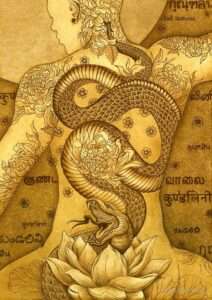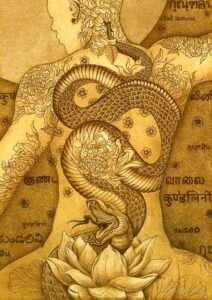What Are the 7 Chakras & How to Balance Your Energy Centers?
- Published:
- Written by: Stefany Ungari

The concept of Chakras has been around for centuries, and it is a widely used practice in many cultures.
Chakras refer to the seven energy centers in the body that are responsible for maintaining physical, emotional, and spiritual well-being.
Each of these seven chakras is associated with a specific color, symbol, and element.
In this article, we will explore the seven chakras in detail and discuss their significance in maintaining balance and harmony in our lives.
What Are Chakras?
The term Chakra is derived from the Sanskrit language, which means “wheel.” Chakras are essentially energy centers in the body that are responsible for the proper functioning of different organs and systems.
There are seven chakras located throughout the body, from the base of the spine to the top of the head. Each chakra is associated with a specific color, symbol, and element.
What Are the Seven Chakras?
The seven chakras each of us have in our bodies include the following:
1. Root Chakra (Muladhara)
The Root Chakra is located at the base of the spine, and its color is red. This chakra is associated with the element of earth and represents the foundation of our being. It is responsible for our basic survival instincts, such as food, shelter, and safety.
A balanced Root Chakra leads to a sense of security, stability, and grounding.
2. Sacral Chakra (Svadhisthana)
The Sacral Chakra is located in the lower abdomen, and its color is orange. This chakra is associated with the element of water and represents our creativity and sexuality. It is responsible for our emotions, pleasure, and joy.
A balanced Sacral Chakra leads to healthy relationships, creativity, and a sense of abundance.
3. Solar Plexus Chakra (Manipura)
The Solar Plexus Chakra is located in the upper abdomen, and its color is yellow. This chakra is associated with the element of fire and represents our personal power and self-esteem. It is responsible for our willpower, confidence, and courage.
A balanced Solar Plexus Chakra leads to a sense of personal power, inner strength, and self-confidence.
4. Heart Chakra (Anahata)
The Heart Chakra is located in the center of the chest, and its color is green. This chakra is associated with the element of air and represents our ability to love and connect with others. It is responsible for our emotions, compassion, and kindness.
A balanced Heart Chakra leads to loving relationships, empathy, and a sense of inner peace.
5. Throat Chakra (Vishuddha)
The Throat Chakra is located in the throat, and its color is blue. This chakra is associated with the element of sound and represents our ability to communicate and express ourselves. It is responsible for our creativity, self-expression, and authenticity.
A balanced Throat Chakra leads to effective communication, creativity, and clear self-expression.
6. Third Eye Chakra (Ajna)
The Third Eye Chakra is located in the center of the forehead, and its color is indigo. This chakra is associated with the element of light and represents our intuition and wisdom. It is responsible for our perception, insight, and imagination.
A balanced Third Eye Chakra leads to clear perception, intuition, and spiritual awareness.
7. Crown Chakra (Sahasrara)
The Crown Chakra is located at the top of the head, and its color is violet or white. This chakra is associated with the element of consciousness and represents our connection to the divine. It is responsible for our spirituality, enlightenment, and sense of oneness with the universe.
A balanced Crown Chakra leads to spiritual awakening, enlightenment, and deep peace.
What Are the Symptoms of Unbalanced Chakras?
When our chakras are unbalanced, it can affect us physically, emotionally, and spiritually. Here are some common symptoms of imbalanced chakras:
- Root Chakra (Muladhara): The root chakra is located at the base of the spine and is associated with our sense of security and stability. When this chakra is imbalanced, you may experience symptoms such as anxiety, fear, restlessness, and physical symptoms like lower back pain or issues with the legs and feet.
- Sacral Chakra (Svadhisthana): The sacral chakra is located in the lower abdomen and is associated with our creativity, sexuality, and emotions. When this chakra is imbalanced, you may experience symptoms such as lack of motivation, feelings of guilt or shame, low libido, or reproductive system issues.
- Solar Plexus Chakra (Manipura): The solar plexus chakra is located in the upper abdomen and is associated with our self-esteem, personal power, and confidence. When this chakra is imbalanced, you may experience symptoms such as low self-esteem, lack of motivation, digestive issues, or adrenal fatigue.
- Heart Chakra (Anahata): The heart chakra is located in the center of the chest and is associated with our ability to love and connect with others. When this chakra is imbalanced, you may experience symptoms such as difficulty in expressing or receiving love, heart-related issues, or feelings of isolation.
- Throat Chakra (Vishuddha): The throat chakra is located in the throat and is associated with our ability to communicate and express ourselves. When this chakra is imbalanced, you may experience symptoms such as difficulty in expressing yourself, fear of speaking up, sore throat, or thyroid issues.
- Third Eye Chakra (Ajna): The third eye chakra is located in the center of the forehead and is associated with our intuition and psychic abilities. When this chakra is imbalanced, you may experience symptoms such as difficulty in concentrating, lack of clarity, headaches, or vision problems.
- Crown Chakra (Sahasrara): The crown chakra is at the top of the head and is associated with our connection to the divine and spiritual nature. When this chakra is imbalanced, you may experience symptoms such as disconnection, lack of purpose, and difficulty in experiencing spiritual connection.
If you’re experiencing any of these symptoms, it may be a sign that one or more of your chakras is imbalanced.
Working on balancing your chakras through various practices can help alleviate these symptoms and bring more balance and harmony into your life.
How to Balance Your Chakras?
There are various ways to balance the chakras, and some of the most effective methods include the following:
Meditation:
Meditation is one of the most powerful tools for balancing the chakras. It involves sitting in a quiet place, focusing on your breath, and visualizing each chakra in your body.
Yoga:
Yoga is an excellent practice for balancing the chakras. Each yoga pose is associated with a specific chakra and helps to activate and balance it.
Energy Healing:
Energy healing is a holistic approach to healing that involves the use of various techniques such as Reiki, acupuncture, and acupressure to balance the chakras.
Affirmations:
Affirmations are positive statements that help to reprogram your subconscious mind and align your energy with your intentions. You can use affirmations to balance each chakra by repeating positive statements related to that chakra.
Aromatherapy:
Aromatherapy involves the use of essential oils to balance the chakras. Each essential oil is associated with a specific chakra and helps to activate and balance it.
KAP Kundalini Activation
A Kundalini Activation is a powerful tool that can help you activate your Kundalini energy, leading to a range of benefits for your overall well-being.
By harnessing the transformative power of Kundalini Alchemy Path, you can experience a deeper connection to your inner self, greater intuition, heightened awareness, and a more balanced energy flow through your chakras.
If you want to unleash your Kundalini energy’s full potential, Kundalini Activation session can help you achieve just that.
Our team of experienced practitioners can guide you through the process, ensuring that you receive the full benefits of this powerful technique.
Whether you’re looking to release emotional blockages, improve your physical health, or connect with your spiritual side, the power of the Kundalini Alchemy Path can help you achieve your goals.
Rebalance With a KAP Session Today
Book your KAP session today and take the first step towards unlocking the full potential of your Kundalini energy.





